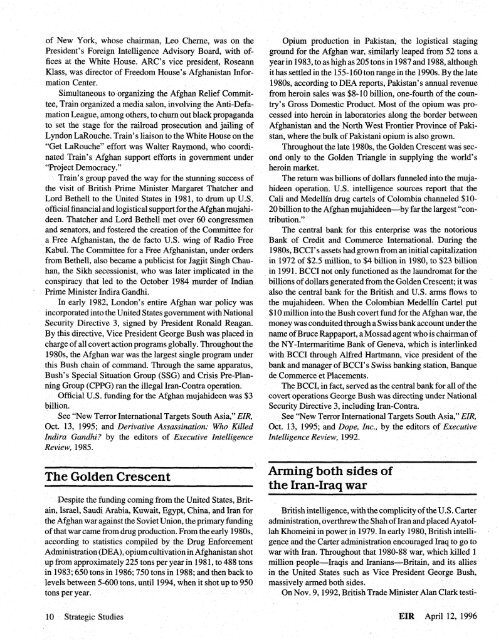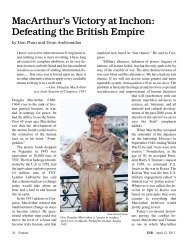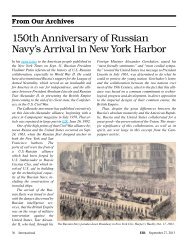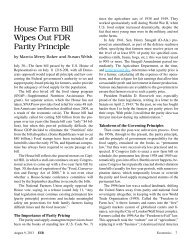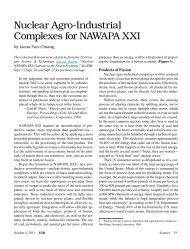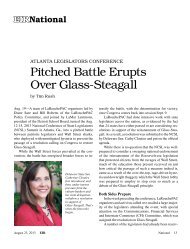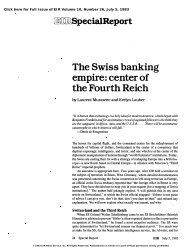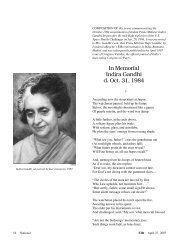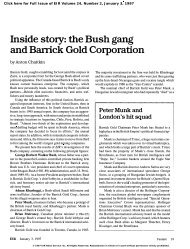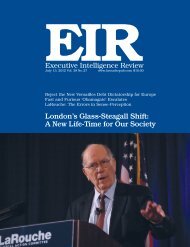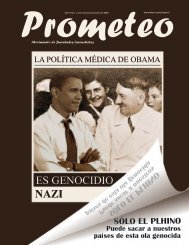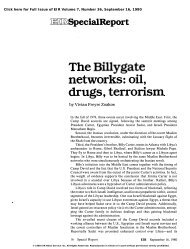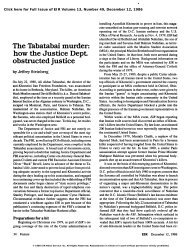Full Issue (PDF) - Executive Intelligence Review
Full Issue (PDF) - Executive Intelligence Review
Full Issue (PDF) - Executive Intelligence Review
Create successful ePaper yourself
Turn your PDF publications into a flip-book with our unique Google optimized e-Paper software.
of New York, whose chairman, Leo Cheme, was on the<br />
President's Foreign <strong>Intelligence</strong> Advisory Board, with offices<br />
at the White House. ARC'S vice president, Roseann<br />
Klass, was director of Freedom House's Afghanistan Information<br />
Center.<br />
Simultaneous to organizing the Afghan Relief Committee,<br />
Train organized a media salon, involving the Anti-Defamation<br />
League, among others, to chum out black propaganda<br />
to set the stage for the railroad prosecution and jailing of<br />
Lyndon LaRouche. Train's liaison to the White House on the<br />
"Get LaRouche" effort was Walter Raymond, who coordinated<br />
Train's Afghan support efforts in government under<br />
"Project Democracy."<br />
Train's group paved the way for the stunning success of<br />
the visit of British Prime Minister Margaret Thatcher and<br />
Lord Bethell to the United States in 1981, to drum up U.S.<br />
official financial and logistical support for the Afghan mujahideen.<br />
Thatcher and Lord Bethell met over 60 congressmen<br />
and senators, and fostered the creation of the Committee for<br />
a Free Afghanistan, the de facto U.S. wing of Radio Free<br />
Kabul. The Committee for a Free Afghanistan, under orders<br />
from Bethell, also became a publicist for Jagjit Singh Chauhan,<br />
the Sikh secessionist, who was later implicated in the<br />
conspiracy that led to the October 1984 murder of Indian<br />
Prime Minister Indira Gandhi.<br />
In early 1982, London's entire Afghan war policy was<br />
incorporated into the United States government with National<br />
Security Directive 3, signed by President Ronald Reagan.<br />
By this directive. Vice President George Bush was placed in<br />
charge of all covert action programs globally. Throughout the<br />
1980s, the Afghan war was the largest single program under<br />
this Bush chain of command. Through the same apparatus,<br />
Bush's Special Situation Group (SSG) and Crisis Pré-Planning<br />
Group (CPPG) ran the illegal Iran-Contra operation.<br />
Official U.S. funding for the Afghan mujahideen was $3<br />
billion.<br />
See "New Terror International Targets South Asia," EIR,<br />
Oct. 13, 1995; and Derivative Assassination: Who Killed<br />
Indira Gandhi? by the editors of <strong>Executive</strong> <strong>Intelligence</strong><br />
<strong>Review</strong>, 1985.<br />
The Golden Crescent<br />
Despite the funding coming from the united States, Britain,<br />
Israel, Saudi Arabia, Kuwait, Egypt, China, and Iran for<br />
the Afghan war against the Soviet Union, the primary funding<br />
ofthat war came from drug production. From the early 1980s,<br />
according to statistics compiled by the Drug Enforcement<br />
Administration (DEA), opium cultivation in Afghanistan shot<br />
up from approximately 225 tons per year in 1981, to 488 tons<br />
in 1983; 650 tons in 1986; 750 tons in 1988; and then back to<br />
levels between 5-600 tons, until 1994, when it shot up to 950<br />
tons per year.<br />
Opium production in Pakistan, the logistical staging<br />
ground for the Afghan war, similarly leaped from 52 tons a<br />
year in 1983, to as high as 205 tons in 1987 and 1988, although<br />
it has settled in the 155-160 ton range in the 1990s. By the late<br />
1980s, according to DEA reports, Pakistan's annual revenue<br />
from heroin sales was $8-10 billion, one-fourth of the country's<br />
Gross Domestic Product. Most of the opium was processed<br />
into heroin in laboratories along the border between<br />
Afghanistan and the North West Frontier Province of Pakistan,<br />
where the bulk of Pakistani opium is also grown.<br />
Throughout the late 1980s, the Golden Crescent was second<br />
only to the Golden Triangle in supplying the world's<br />
heroin market.<br />
The return was billions of dollars funneled into the mujahideen<br />
operation. U.S. intelligence sources report that the<br />
Cali and Medellin drug cartels of Colombia channeled $10-<br />
20 billion to the Afghan mujahideen—by far the largest "contribution."<br />
The central bank for this enterprise was the notorious<br />
Bank of Credit and Commerce International. During the<br />
1980s, BCCI's assets had grown from an initial capitalization<br />
in 1972 of $2.5 million, to $4 billion in 1980, to $23 billion<br />
in 1991. BCCI not only functioned as the laundromat for the<br />
billions of dollars generated from the Golden Crescent; it was<br />
also the central bank for the British and U.S. arms flows to<br />
the mujahideen. When the Colombian Medellin Cartel put<br />
$10 million into the Bush covert fund for the Afghan war, the<br />
money was conduited through a Swiss bank account under the<br />
name of Bruce Rappaport, a Mossad agent who is chairman of<br />
the NY-Intermaritime Bank of Geneva, which is interlinked<br />
with BCCI through Alfred Hartmann, vice president of the<br />
bank and manager of BCCI's Swiss banking station. Banque<br />
de Commerce et Placements.<br />
The BCCI, in fact, served as the central bank for all of the<br />
covert operations George Bush was directing under National<br />
Security Directive 3, including Iran-Contra.<br />
See "New Terror International Targets South Asia," EIR,<br />
Oct. 13, 1995; and Dope, Inc., by the editors of <strong>Executive</strong><br />
<strong>Intelligence</strong> <strong>Review</strong>, 1992.<br />
Arming both sides of<br />
the Iran-Iraq war<br />
British intelligence, with the complicity of the U.S. Carter<br />
administration, overthrew the Shah of Iran and placed Ayatollah<br />
Khomeini in power in 1979. In early 1980, British intelligence<br />
and the Carter administration encouraged Iraq to go to<br />
war with Iran. Throughout that 1980-88 war, which killed 1<br />
million people—Iraqis and Iranians—Britain, and its allies<br />
in the United States such as Vice President George Bush,<br />
massively armed both sides.<br />
On Nov. 9,1992, British Trade Minister Alan Clark testi-<br />
10 Strategic Studies EIR April 12, 1996


